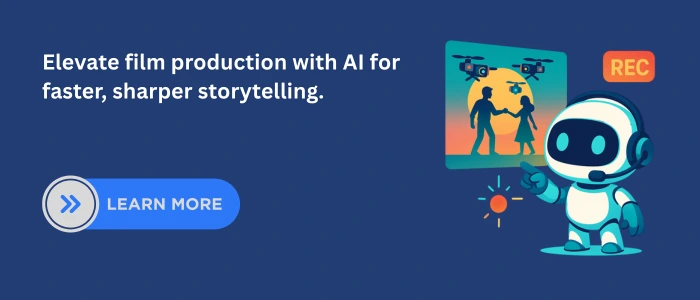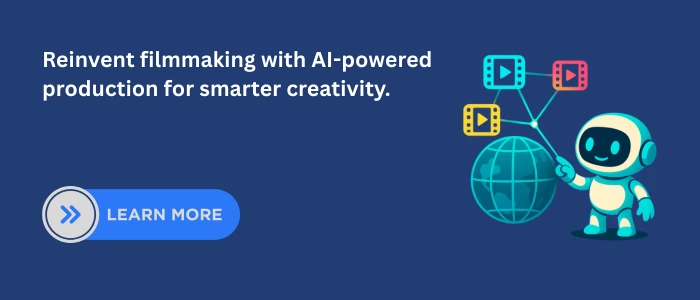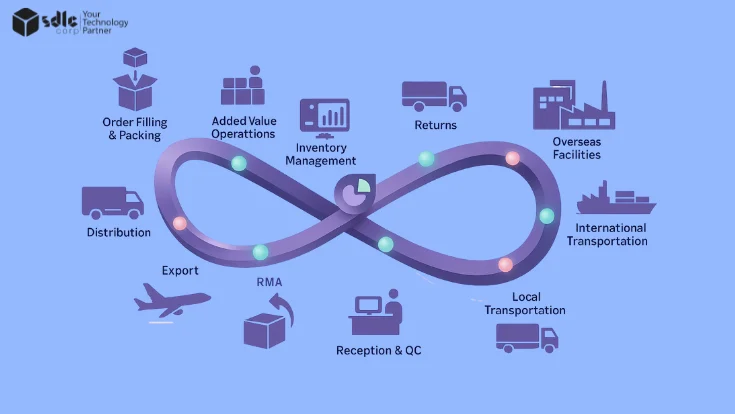Introduction
Artificial Intelligence is revolutionizing how stories are conceived, filmed, and delivered. From early-stage ideation to final rendering, AI for Film and Production is transforming every aspect of modern cinema. Intelligent systems now assist in generating scripts, enhancing visual effects, and automating editing workflows making content creation faster, smarter, and more cost-effective.
With the help of AI development services and custom AI solutions, filmmakers, producers, and studios can make data-driven creative decisions that merge automation with artistry. This synergy streamlines production pipelines while preserving exceptional quality, allowing creative teams to focus more on storytelling and innovation rather than technical constraints.
In the following sections, we’ll explore how AI is redefining pre-production, production, and post-production through predictive analytics, smart rendering, and adaptive storytelling that are shaping the future of cinema.
1. The Foundations of AI for Film and Production
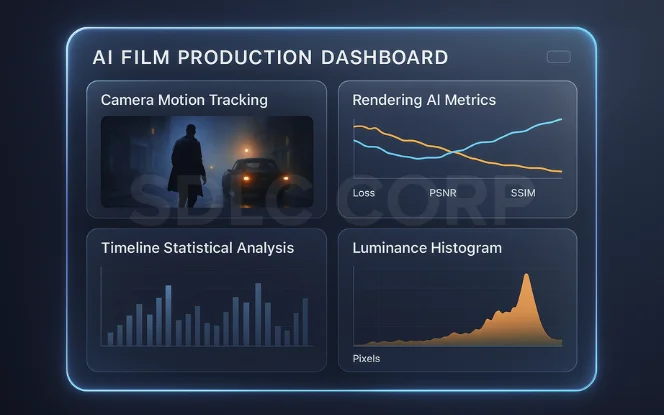
Artificial Intelligence has become the creative engine behind modern cinema’s transformation. By integrating advanced computational techniques, AI for Film and Production is redefining how stories are written, visualized, and brought to life. The fusion of data-driven intelligence with creative artistry is driving the industry toward a new era of speed, precision, and imagination.
Core Technologies in AI for Film and Production
At the heart of this revolution lie powerful technologies such as machine learning (ML), natural language processing (NLP), computer vision, and deep generative models. ML enables systems to learn from vast datasets scripts, visuals, or audience preferences while NLP interprets dialogue, tone, and emotional structure. Computer vision powers automated editing, scene recognition, and visual effects, whereas deep generative models create lifelike imagery and synthetic environments that blur the line between reality and simulation.
- AI is enhancing script generation and storyboarding, allowing filmmakers to visualize and refine ideas faster.
- Film and Production is optimizing camera motion prediction and pre-visualization, ensuring smoother, more dynamic shots on set.
- AI for Film and Production is accelerating post-production and rendering pipelines, drastically reducing manual effort and production costs.
Historical & Industrial Context
The journey from digital to computational cinema marks a profound shift in filmmaking. Initially, digital tools simplified editing and effects; however, today’s AI for Film and Production tools actively collaborate with creators suggesting edits, generating visuals, and predicting audience impact. This transition has made the film industry increasingly data-centric and innovation-driven. Globally, studios and streaming platforms are adopting AI at record speed, from Hollywood’s virtual production stages to independent filmmakers leveraging AI-driven post-production. As the ecosystem matures, AI for Film and Production continues to evolve as both a technological foundation and a creative collaborator in the cinematic arts.
Explore More : Generative AI for Film and Production
2. Benefits of AI for Film and Production
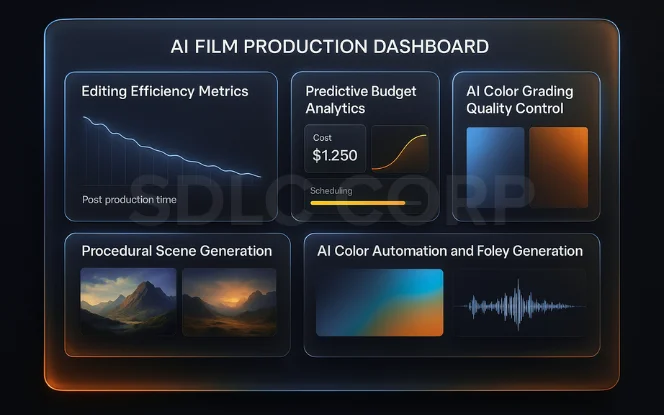
The integration of Artificial Intelligence has ushered in a measurable leap in film productivity, creativity, and profitability. By automating complex processes and enhancing precision, AI for Film and Production enables studios and creators to achieve unprecedented scalability. As a result, tasks that once took weeks can now be completed in hours, leading to improved efficiency metrics, reduced costs, and elevated creative freedom.
Advantages Driving AI in Film and Production
- Time compression in editing workflows: AI for Film and Production significantly shortens post-production cycles by automating cutting, scene matching, and color correction. Consequently, editors can focus more on creative storytelling instead of repetitive technical labor.
- Predictive analytics for budget and scheduling: Through real-time data modeling, AI for Film and Production forecasts cost fluctuations, crew requirements, and shooting timelines. Moreover, it minimizes financial risks by optimizing schedules and preventing budget overruns.
- Procedural generation for scenes and effects: AI for Film and Production uses generative algorithms to create dynamic environments and effects, saving both time and resources. Furthermore, this technology supports scalable world-building for both large studios and indie creators.
- Quality assurance via AI color grading: Advanced vision models automatically balance hues, tones, and brightness for consistent visual aesthetics. As a result, AI for Film and Production ensures high-quality output across different lighting conditions and camera types.
- Intelligent casting and audience targeting: Consequently, AI for Film and Production analyzes audience sentiment, demographics, and engagement data to match ideal actors with roles. This leads to stronger market resonance and more successful film releases.
- Automation in sound engineering and Foley: Furthermore, AI for Film and Production automates background sound creation, syncs audio with visuals, and enhances ambient textures. This accelerates the audio production pipeline while maintaining cinematic depth and realism.
3. Use Cases and Workflow Integration of AI for Film and Production
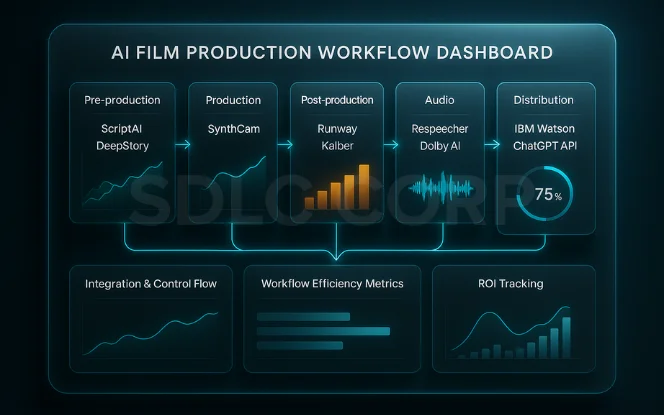
Artificial Intelligence is redefining the entire filmmaking pipeline—from initial script ideation to global distribution. By embedding intelligent systems at every stage, AI for Film and Production not only enhances creative efficiency but also introduces data-driven precision into traditionally manual processes. The following table outlines real-world applications, tools, and measurable outcomes across various phases of production.
Table Practical Use Cases of AI for Film and Production
| Area | Use Case | Tool/Example | Outcome |
|---|---|---|---|
| Pre-production | Script ideation, storyboarding | ScriptAI, DeepStory | Faster creative ideation |
| Production | Virtual cinematography | SynthCam | Reduced reshoot cost |
| Post-production | VFX generation | Runway, Kaiber | 10× render speed |
| Audio | ADR, sound cleanup | Respeecher, Dolby AI | Clean audio in minutes |
| Distribution | Predictive audience analytics | IBM Watson, ChatGPT API | Targeted marketing |
Integration & Control Flow
In practical terms, studios can adopt AI for Film and Production through a progressive logic model:
- If the studio’s primary challenge lies in storytelling or creative ideation, it should begin with NLP-based tools for script analysis and story generation.
- If budget or time constraints dominate, automation tools in VFX or post-production offer the quickest returns.
- Otherwise, leveraging AI analytics for forecasting audience trends and optimizing release strategies ensures long-term value creation.
This modular approach allows seamless scaling from creative exploration to full production automation while maintaining human oversight in critical decision points.
Deployment Roadmap
- (T) Initiate pilot with low-risk modules.
- (T) Gather data feedback and retrain models for improved accuracy.
- (T) Scale successful modules into full production environments.
- (T) Integrate generative tools for faster creative turnaround.
- Monitor ROI and performance metrics across all iterations.
- Upskill internal teams for AI system supervision and creative alignment.
- Create transparent documentation for compliance and governance.
- Link internal databases to establish continuous learning loops and data consistency.
Through this structured adoption roadmap, studios can transform creative ambition into sustainable production innovation making AI for Film and Production both a technological foundation and a strategic growth engine.
4. Challenges and Solutions for AI in Film and Production
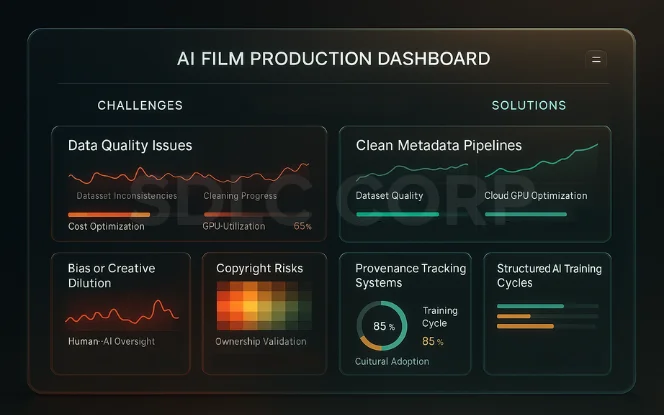
While the potential of AI for Film and Production is extraordinary, its integration presents several technical, ethical, and creative hurdles. Many studios face challenges such as limited access to high-quality training data, escalating compute costs, and concerns about intellectual property ownership. Additionally, maintaining the delicate balance between human creativity and algorithmic automation remains an ongoing concern across the filmmaking ecosystem.
- (T) Data quality issues → To ensure accuracy and artistic relevance, AI for Film and Production teams build proprietary datasets and clean metadata for reliable training pipelines.
- (T) High compute costs → Moreover, production houses leverage cloud GPU leasing and collaborative rendering to optimize resources while maintaining scalability.
- (T) Bias or creative dilution → Consequently, AI for Film and Production workflows now include hybrid human-AI oversight, ensuring artistic integrity and inclusivity.
- (T) Copyright risks → Furthermore, professionals implement AI provenance tracking systems to verify ownership and safeguard creative assets.
- (T) Team adaptation → Finally, AI for Film and Production success depends on structured training cycles and transparent communication protocols to foster cultural acceptance.
Through these mitigation strategies, studios can embrace the benefits of AI for Film and Production while minimizing risks, ensuring that the technology enhances—rather than replaces—the human imagination that drives cinema forward.
Know About This : AI in Media and Entertainment
5. Implementation Framework for AI for Film and Production
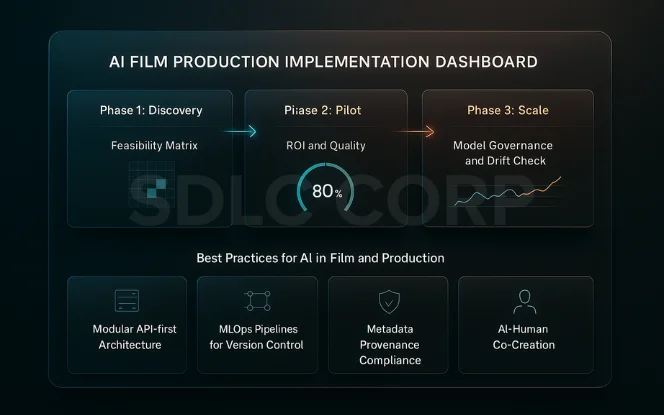
Operationalizing Artificial Intelligence within the film industry requires a structured, phased approach. By aligning creative and technical objectives, AI for Film and Production can be integrated seamlessly into studio pipelines, ensuring efficiency without compromising artistic intent. This framework outlines a roadmap for producers, directors, and technical teams to adopt AI strategically and sustainably.
Phased Roadmap of AI Implementation in Film and Production
| Phase | Objective | Key Deliverables |
|---|---|---|
| Discovery | Identify workflows suitable for automation | Feasibility matrix |
| Pilot | Validate single process and measure impact | ROI, quality metrics |
| Scale | Integrate AI across the full pipeline | Model governance, drift check |
This progression enables studios to test, refine, and expand AI for Film and Production deployments while managing risk and maintaining creative integrity.
Best Practices for AI in Film and Production
- Adopt modular, API-first architecture: Build adaptable infrastructures that allow AI tools to integrate with existing production software effortlessly.
- Maintain MLOps pipelines for version control: Ensure consistent monitoring, retraining, and auditing of machine learning models for long-term stability.
- Enforce creative audit trails: Record all AI-driven edits, visual generations, and metadata changes for transparency and accountability.
- Use metadata provenance for compliance: Track the origin, usage rights, and transformation history of all AI-generated content to meet legal standards.
- Encourage AI-human co-creation: Promote collaboration between creative professionals and intelligent systems to maintain authenticity and innovation.
Through disciplined deployment and ethical oversight, studios can transform production ecosystems—achieving faster turnarounds, data-backed decision-making, and creative amplification powered by AI for Film and Production.
Read Also : Decentralizing Content Distribution: Blockchain’s Impact on Film and Music Industries
6. Investor and Business Insights on AI for Film and Production
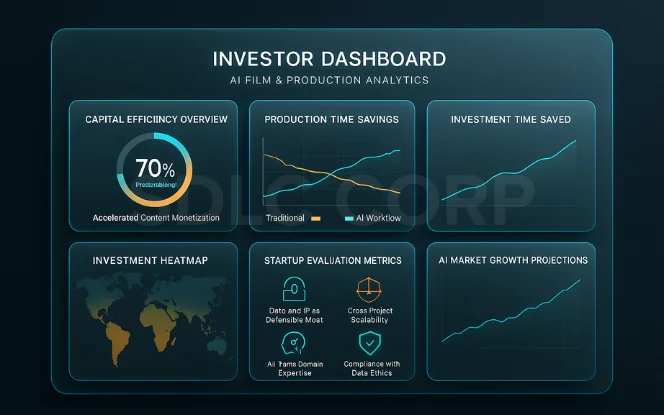
Investors are increasingly recognizing the transformative potential of AI for Film and Production as a catalyst for faster monetization cycles and long-term creative scalability. By automating key processes—such as editing, VFX, and distribution—AI reduces both production time and operational overhead. This compression of creative timelines allows content to reach audiences sooner, directly boosting cash flow and asset turnover for studios and investors alike.
Furthermore, capital efficiency and predictable ROI have made AI for Film and Production one of the most attractive frontiers for media investment. AI-driven analytics improve decision-making accuracy, while automation minimizes risk exposure associated with budget overruns or project delays. As a result, both venture capitalists and strategic media funds are channeling resources into startups that merge storytelling with intelligent automation.
Evaluation Parameters for Film-Tech Startups
- (T) Data and IP as defensible moat: Proprietary datasets, unique content models, and IP-backed pipelines form strong entry barriers against competitors.
- (T) Cross-project scalability: Startups must demonstrate how their AI tools can adapt across diverse film genres and production scales.
- (T) AI team’s domain expertise: Investors look for teams with hybrid skills—cinematic understanding combined with technical mastery in machine learning.
- (T) Compliance with data ethics: Transparent data sourcing and adherence to evolving global regulations are essential for sustainable growth.
By aligning creative innovation with solid financial logic, investors can unlock enduring value and shape the next evolution of entertainment through AI-driven production ecosystems.
7. Case Studies of AI for Film and Production Success
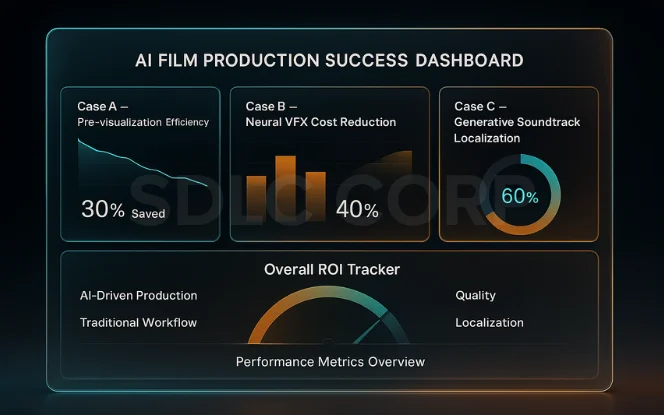
The real-world adoption of AI for Film and Production demonstrates measurable returns across creative and operational dimensions. From independent filmmakers to major studios, intelligent automation and data-driven insights have redefined efficiency, quality, and profitability. Below are key case studies showcasing how AI has tangibly transformed production workflows and outcomes.
- (T) Case A – AI-based pre-visualization cut 30% time for an indie film: Using generative pre-visualization tools, an independent studio reduced its planning and scene-design phase by almost one-third. This application of AI for Film and Production allowed creative teams to visualize lighting, camera angles, and compositions instantly, accelerating the move from concept to camera-ready execution.
- (T) Case B – Neural VFX pipeline reduced costs by 40%: A mid-sized production company adopted a neural rendering pipeline for its visual effects department. By leveraging AI for Film and Production, the studio replaced manual compositing with automated scene reconstruction, resulting in 40% lower rendering costs and consistent visual fidelity across scenes.
- (T) Case C – Generative soundtrack AI improved localization for global audiences: A major streaming platform implemented AI-driven music scoring and dubbing tools to tailor content for diverse markets. Consequently, AI for Film and Production enabled multilingual soundtracks and emotion-aligned background scores, improving localization efficiency by 60%.
Collectively, these examples highlight the economic and creative scalability of AI for Film and Production. Each success story reinforces how data, automation, and machine intelligence can coexist with artistic vision. The core learning is clear—when integrated thoughtfully, AI for Film and Production not only enhances storytelling but also ensures that every frame and every dollar deliver measurable value.
Learn More : Interactive Storytelling: The Intersection of Film and Gaming
8. Future Trends in AI for Film and Production

The next wave of innovation will see AI for Film and Production evolve from a supportive tool into a fully collaborative creative partner. As technology advances, film ecosystems will transition toward hyper-personalized storytelling, immersive virtual sets, and globally scalable production pipelines. Studios will rely on intelligent systems that anticipate artistic intent, optimize resources, and maintain ethical balance between human creativity and machine autonomy.
Next-Gen Possibilities with AI for Film and Production
- Autonomous editing and real-time compositing: Instant scene assembly through adaptive algorithms that edit in sync with narrative flow.
- Fully synthetic actors and voice doubles: Realistic digital performers capable of multilingual dialogue and emotional nuance.
- AI governance and creative ethics frameworks: Transparent standards ensuring fairness, authenticity, and creative ownership.
- Integration of metaverse and cinematic pipelines: Seamless collaboration between virtual worlds and film production environments.
Conclusion
The cinematic world is entering a revolutionary era where AI for Film and Production seamlessly merges imagination with innovation. From automating complex workflows to enhancing artistic expression, AI empowers filmmakers, producers, and investors to create more efficiently and with greater precision. With AI development solutions, the industry can harness intelligent tools that elevate storytelling, streamline production, and maximize creative potential.
Now is the time to experiment, invest, and innovate responsibly. By fostering ethical collaboration between humans and machines, the film industry can craft stories that resonate more deeply, reach broader audiences, and redefine what’s possible on screen in this new age of intelligent cinema.
FAQs
1. What is AI for Film and Production?
AI for Film and Production refers to the use of artificial intelligence tools and algorithms to automate, enhance, and optimize various stages of filmmaking — from scriptwriting and editing to VFX and marketing.
2. How does AI improve the filmmaking process?
AI improves efficiency by automating repetitive tasks like editing, scene rendering, and color grading while providing data-driven insights that enhance storytelling and audience targeting.
3. What are the benefits of using AI for Film and Production?
It enables faster production cycles, reduced costs, better creative control, predictive analytics for investment decisions, and high-quality visual outputs with fewer human errors.
4. Are filmmakers replacing humans with AI?
No, AI complements human creativity rather than replacing it. It acts as a collaborative tool that enhances artistic vision and streamlines technical workflows.
5. What is the future of AI in the film industry?
The future will see fully automated editing, synthetic actors, AI-driven storytelling, and seamless integration between film pipelines and metaverse environments.

